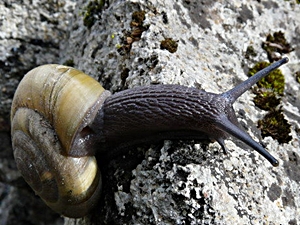
Algiers snail (Zonites algirus). (Source).
 Algiers snail (Zonites algirus). (Source). |
The shell of most zonitid snails is glassy and sometime translucent. Apart from that, the family is very variable in their appearance. The shell may be commonly glassy and smooth, but it other regards it is rather variable: It can have a disc shape or a depressed conical shape and the snails can be small or rather large.
Concerning their vernacular or common name, the true glass snails are hard to distinguish from the glass snails (Vitrinidae). Those tiny snails are only related and have a completely different outward appearance. There is, though, no other vernacular name, which makes the scientific names as much more important for an unambiguous description of snail species!
The largest true glass snail native to Central Europe is Aegopis verticillus, also referred to as giant glass snail, whose shell may be 30 mm wide, as large as a small Roman snail. There are though, larger species in the Mediterranean, such as the Algiers snail (Zonites algirus) from the southern Peloponnesus, adjacent Greek islands, the coast of Asia Minor, and interestingly also Southern France and Southern Italy, with a maximal shell width of 55 mm.
While the true glass snails, in contrary to many glass snails (Vitrinidae), are able to withdraw into their shell completely, there is, however, a tendency to vitrinisation, the reduction of the shell for the benefit of better movability and for the sake of protection, in their vicinity as well: The closely related family of the carnivorous Daudebardias (Daudebardiinae) has already progressed to an advanced stage of vitrinisation: Daudebardias are practically slugs, with a very small shell at the end of their foot, in which they cannot withdraw anymore.
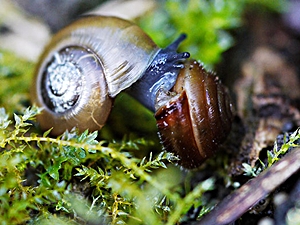 A wide mouthed glass snail (Aegopinella nitens) attacking a Petasina unidentata. Picture: © Stefan Haller, (Source). |
The area with the largest species diversity of true glass snails is located in South-East Europe, where true glass snails live mainly in humid places in mountains, rock crevices and rock rubble fields.
Among them there are many almost entirely carnivorous species, feeding on other snails, but also on earth worms. Other species also feed on decaying plant matter and on carrion. As juveniles, but not only then, true glass snails also feed on other snails' eggs.
In older systematics, all true glass snails were assembled in the Zonitidae family, which belonged to the Vitrinoidea superfamily of relatives of glass snails.
![]() Relatives of glass snails (Vitrinoidea).
Relatives of glass snails (Vitrinoidea).
New research results, however, have yielded that true glass snails as such must be divided into two different families from two different superfamilies:
Superfamily Zonitoidea
![]() Family
Zonitidae
Family
Zonitidae
![]() Genus
Zonites
Genus
Zonites
![]() Genus
Aegopis
Genus
Aegopis
Superfamily Gastrodontoidea
![]() Family
Oxychilidae
Family
Oxychilidae
![]() Subfamily
Oxychilinae
Subfamily
Oxychilinae
![]() Genus
Oxychilus
Genus
Oxychilus
![]() Subfamily
Godwiniinae
Subfamily
Godwiniinae
![]() Genus
Aegopinella
Genus
Aegopinella
![]() Subfamily
Daudebardiinae
Subfamily
Daudebardiinae
![]() Genus
Daudebardia
Genus
Daudebardia
![]() Family
Pristilomatidae
Family
Pristilomatidae
![]() Genus
Vitrea
Genus
Vitrea
Source: Fauna Europaea on http://www.faunaeur.org.
![]() Daudebardias (Daudebardiinae).
Daudebardias (Daudebardiinae).
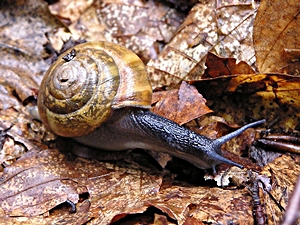 Aegopis verticillus on Wilhelminenberg hill in Vienna. [RN] |
In the Zonitidae family, only the larger genera Aegopis and Zonites are left.
Among the Godwiniinae, the genera Nesovitrea, Aegopinella and Retinella are native to Europe.
Wide Mouthed Aegopinella - Aegopinella nitens (Michaud 1831)
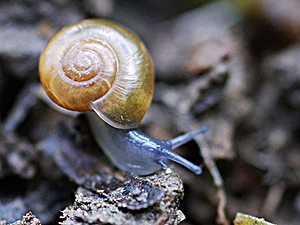 Wide mouthed Aegopinella (Aegopinella nitens). Picture: © Stefan Haller, (schneckenfoto.ch). |
Description: The wide mouthed Aegopinella has a light brownish horn coloured shell. The shell spire is flatly conical, the shell tip (apex) is not convex (A difference to the slightly smaller Aegopinella nitidula). The sidelines of the slightly rounded whorls are almost flat. Before the aperture the last whorl widens distinctly, reaching about triple the previous whorl's width. It is flattened and does not descent at the aperture, which is only slightly oblique. The shell navel (umbilicus) is wide and funnel-shaped.
Dimensions: H: 4 - 5.5 mm; W: 8 - 11 mm (in the Alps up to 14 mm); N: 4 - 4½. (Abbreviations).
Habitat and Distribution: Wide mouthed Aegopinellas live in the leaf litter and under stones in humid forests, as well in the valleys, as on the slopes. Aegopinella nitens prefers calciferous ground, especially in submontane and montane altitudes.
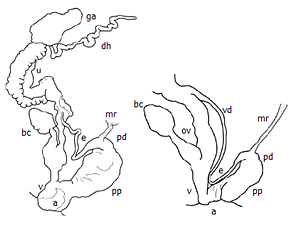 |
The wide mouthed Aegopinella can be found in the Alps, the western Carpathians and the German and Czech low mountain ranges. The northernmost finding site of Aegopinella nitens is near Bad Pyrmont in southern Lower Saxony. In the Alps, the wide mouthed Aegopinella climbs to altitudes of up to 2300 m MSL, but it rarely goes beyond 1500 m MSL.
|
|
Picture right: Genital apparatuses of Aegopinella nitens (left) and Aegopinella nitidula (right) in comparison. Description: ga: Albumen gland; dh: Hermaphroditic duct; u: Uterus; ov: Oviduct; vd: Vas deferens; e: Epiphallus; pd: Penis, distal; pp: Penis, proximal; v: Vagina; bc: Bursa copulatrix; a: Atrium; mr: Penis retractor. (see. Organs of the Genital Appa-ratus). Source: Horsàk, M.; Juřičkovà, L.; Beran, L.; Čejka, T.; Dvořàk, L.: Annotated list of mollusc species recorded outdoors in the Czech and Slovak Republics. Malacologica Bohemoslovaca (2010), Suppl. 1: 1–37. |
Threat Situation: In Lower Saxony, the wide mouthed Aegopinella has
been classified as endangered (EN) (see also:
![]() IUCN Threat Categories).
IUCN Threat Categories).
![]() Francisco Welter-Schultes:
Aegopinella nitens species homepage.
Francisco Welter-Schultes:
Aegopinella nitens species homepage.
![]() Mollbase:
Wide mouthed Aegopinella (Aegopinella nitens).
Mollbase:
Wide mouthed Aegopinella (Aegopinella nitens).
Reddish Aegopinella - Aegopinella nitidula (Draparnaud 1805)
height="252">
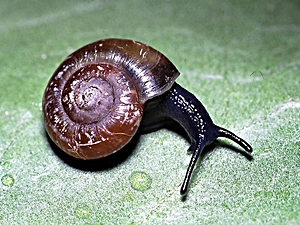 Reddish glass snail (Aegopinella nitidula). Picture: Kristiina Ovaska. Source: CalPhotos. |
Description: Like the name already says, the reddish Aegopinella has a reddish to amber coloured shell, which becomes whitish near the shell navel (umbilicus). The shell whorls widen regularly, are rounded at the outside and the shell tip (apex) is convex, in contrary to Aegopinella nitens, whose apex is flatter. The last whorl is only slightly widened, the umbilicus is wide.
Dimensions: H: 4 - 6 mm; W: 6 - 11; N: 3.5 - 4.5. (Abbreviations).
Habitat and Distribution: The reddish Aegopinella lives in the leaf litter of many protected habitats, such as in deciduous and coniferous forest, at the foot of rocks and walls, on humid meadows, in gardens and on the side of paths. Aegopinella nitidula basically is only to a minor extent susceptible to human interference.
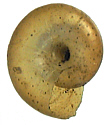 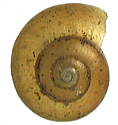 Wide mouthed glass snail (Aegopinella nitens). Picture: Helmut Nisters |
Mainly, Aegopinella nitidula feeds on decaying plant matter. But it is also carnivorous, it hunts smaller snails (up to a diameter of 4.5 mm) and slugs (up to a length of 17 mm). Earth worms and other kinds of worms are also among the reddish glass snail's preferred prey.
This species' distribution area stretches from the Azores over northern Spain, the British Isles and France as far as North Germany, North Poland and the south of Scandinavia. In North America, the species has so far been introduced, for example in British Columbia (Canada).
![]() Francisco
Welter-Schultes:
Aegopinella nitidula species homepage.
Francisco
Welter-Schultes:
Aegopinella nitidula species homepage.
![]() Mollbase:
Reddish Aegopinella (Aegopinella nitidula).
Mollbase:
Reddish Aegopinella (Aegopinella nitidula).
![]() Forsyth,
R. G.; Hutchinson, J. M. C.; Reise,
H. (2001): Aegopinella nitidula (Draparnaud
1805) (Gastropoda: Zonitidae) in British Columbia - first confirmed North
American record. Am. Mal. Bull. 16: 65 - 69 (PDF).
Forsyth,
R. G.; Hutchinson, J. M. C.; Reise,
H. (2001): Aegopinella nitidula (Draparnaud
1805) (Gastropoda: Zonitidae) in British Columbia - first confirmed North
American record. Am. Mal. Bull. 16: 65 - 69 (PDF).
In Central Europe, the genus Oxychilus is divided into three subgenera: Next to Oxychilus, those are Ortizius, Mediterranea, Cellariopsis, Morlina and Riedelius.
![]() Mollbase:
Oxychilus.
Mollbase:
Oxychilus.
Dark Bodied Glass Snail - Oxychilus (Oxychilus) draparnaudi (Beck 1837)
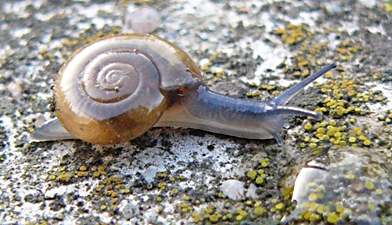 Dark bodied glass snail (Oxychilus draparnaudi). Picture: M. Maňas (Wikipedia). |
Description: The dark bodied glass snail has a brownish horn coloured shell shining mattly, with a more or less distinctly prominent shell tip (apex). The shell surface is striated irregularly. The apertural whorl is more than double as wide as the previous one. The navel (umbilicus) is very wide, almost perspectivic.
Dimensions: H: 6 - 7 mm; W: 12 - 14 mm; N: 5 - 5½. (Abbreviations).
Habitat and Distribution: Oxychilus draparnaudi inhabits humid places under leaves and stones in more or less open country, originally in warm and humid deciduous forests, today, more often in anthropogenous areas, such as gardens, green houses, waste dumps and compost heaps. In parts of Great Britain this species exclusively lives there. Such a species is called commensal.
The dark bodied glass snail is almost exclusively carnivorous. It feeds on juvenile snails and slugs, as well as earth worms. But Oxychilus draparnaudi does also feed on fresh plant matter.
This species' distribution area covers south-western and southern Europe as far north as south-western Germany. It has been introduced in large parts of the Mediterranean, the British Isles, as well as on other continents.
![]() Mollbase:
Oxychilus draparnaudi.
Mollbase:
Oxychilus draparnaudi.
Cellar Snail - Oxychilus (Oxychilus) cellarius (O. F. Müller 1774)
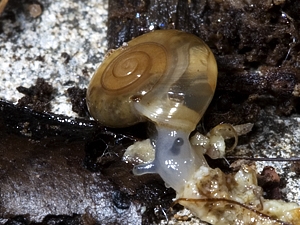 Cellar snail (Oxychilus cellarius) in a Welsh cave. Picture: Andrew Lewington, Cave Life in Wales. |
Description: The cellar snail has a disc shaped, flattened shell with an only slightly elevated spire. The suture between the whorls is flattened and the navel (umbilicus) is open and cone shaped. The shell is almost smooth and shining, translucent and yellowish grey. The snail's body is coloured blue grey, rarely also lighter coloured, especially cave-living specimens. To unambiguously tell this species apart from Oxychilus draparnaudi is only possible by an examination of anatomical characters of the genital apparatus.
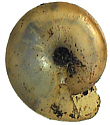 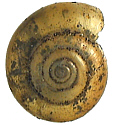 Oxychilus cellarius. Picture: Helmut Nisters. |
Dimensions: H: 3 - 4; W: 10 - 12; N: 6. (Abbreviations).
Habitat and Distribution: Cellar snails originally live in moderately humid deciduous forests under leaves and fallen wood, as well as under stone rubble. As their name states, they also are often found in anthropogenous areas. There they are found under brick rubble, under decaying wood and in damp cellars. The German poet and malacologist Hermann Löns (1866 - 1914), for example, has described Oxychilus cellarius from Westphalian coal cellars.
The cellar snail avoids swamp land, but also live on non-calciferous ground, so in Britain for example, they are found in the moors. Besides, in Britain the cellar snail also is among the cave-living snail species (picture).
The species distribution area originally covers West and Central Europe, including the British Isles with the Hebrides, the Orkneys and the Shetlands. In Norway the cellar snail live along the coast until beyond the Arctic circle. In many other regions of the world, the snail was introduced as a commensal species.
![]() Francisco
Welter-Schultes:
Oxychilus cellarius species homepage.
Francisco
Welter-Schultes:
Oxychilus cellarius species homepage.
![]() Mollbase:
Oxychilus cellarius.
Mollbase:
Oxychilus cellarius.
![]() Andrew Lewington:
Cave Life in Britain.
Andrew Lewington:
Cave Life in Britain.
Garlic Snail - Oxychilus (Ortizius) alliarius (Miller 1822)
 Garlic snail (Oxychilus alliarius). (Source). |
Description: The garlic snail is relatively small with a smooth and shining red-brown shell, whose navel (umbilicus) is quite wide and takes about a sixth of the overall shell width. The snail itself is coloured blackish blue, but may also have a more spectacular, bright blue colour. The snail's name is because, when it is disturbed, it gives off an intense garlic odour.
Dimensions: H: 3.5 - 4 mm; W: 5 - 7 mm; N: 5. (Abbreviations).
Habitat and Distribution: Mainly, the garlic snail lives in swampy habitats in mountainous deciduous forests, in the mosses, under leaves and stones. Besides, it is found in humid places such as stream valleys and the banks of rivers and lakes. In anthropogenous areas, it is also found on humid meadows, in gardens and in green houses. In Switzerland, the garlic snail is found in altitudes of up to 1300 m MSL.
The garlic snail predominantly lives carnivorously, feeding on other snails.
Oxychilus alliarius' distribution area covers North-West Europe as far as Iceland, southern Scandinavia, the British Isles and North Germany. In a dispersed manner, the species also lives in Switzerland, Vorarlberg, Tuscany, Catalonia and the Azores. In many other regions, among others in North America, it has been introduced by man.
![]() Francisco
Welter-Schultes:
Oxychilus alliarius species homepage.
Francisco
Welter-Schultes:
Oxychilus alliarius species homepage.
![]() Mollbase:
Oxychilus alliarius.
Mollbase:
Oxychilus alliarius.
Swiss Glass Snail - Oxychilus (Ortizius) navarricus (Bourguignat 1870)
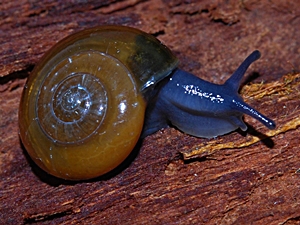 Swiss glass snail (Oxychilus navarricus) from England. Picture: Brian Eversham, (Source). |
Until 2002, the Swiss glass snail was known as Oxychilus helveticus (Blum 1881). Research has yielded that this is a younger synonym of the older (and therefore more valid) name Oxychilus navarricus (Bourguignat 1870).
![]() Falkner,
G.; Ripken, T. E. J.; Falkner,
M. (2002): Mollusques continentaux de France. Liste de référence annotée et
bibliographie. - pp. [1-2], 1-350, [1-3]. Paris.
Falkner,
G.; Ripken, T. E. J.; Falkner,
M. (2002): Mollusques continentaux de France. Liste de référence annotée et
bibliographie. - pp. [1-2], 1-350, [1-3]. Paris.
Description: The Swiss glass snail has a thin-walled shell with a horn-yellow colour and an almost globular outline. Near the shell navel (umbilicus) the colour becomes whitish. The suture between the whorls is only slightly visible. The navel is not very wide, it only takes about an eighth of the shell diameter. In this, the species is different from Oxychilus alliarius, whose navel, in relation, is wider. Near the aperture, through the translucent shell, the characteristic blackish mantle rim is visible.
Dimensions: H: 4.5 - 6 mm; W: 7 - 13; N: 4½ - 6. (Abbreviations).
Habitat and Distribution: The Swiss glass snail inhabits humid and shady habitats in forests and between rock rubble. Mainly, the species is found in mountainous deciduous forests under mosses. To a larger extent than Oxychilus alliarius, it prefers calciferous ground. In Switzerland the Swiss glass snail is found in altitudes of up to 1600 m MSL. Additionally it lives in stream valleys, as well as near springs and, same like the cellar snail, in caves. In Britain, the Swiss glass snail very frequently lives commensally, there it is also found in old quarries, at the roadside and between garbage.
![]() Francisco
Welter-Schultes:
Oxychilus
navarricus species homepage.
Francisco
Welter-Schultes:
Oxychilus
navarricus species homepage.
![]() Anderson, R. (2008): "An annotated list of the non-marine Mollusca of Britain and
Ireland" (PDF).
Anderson, R. (2008): "An annotated list of the non-marine Mollusca of Britain and
Ireland" (PDF).
 With pictures by Stefan Haller: http://www.schneckenfoto.ch. |